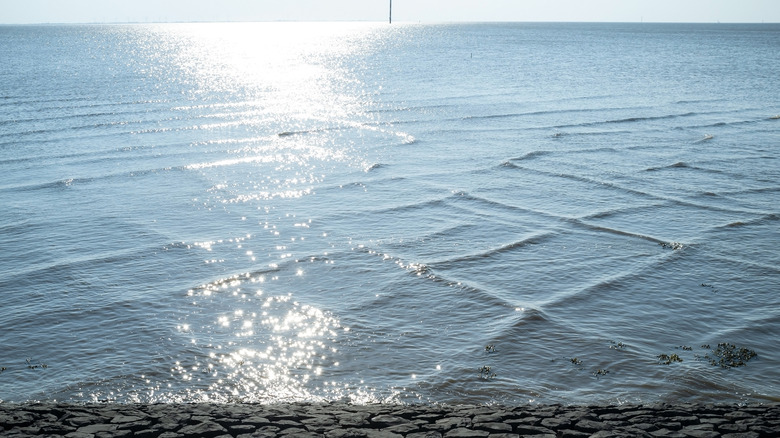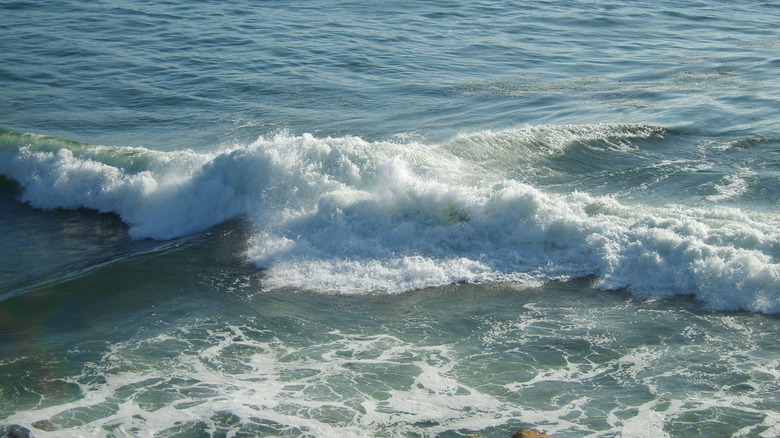Why Square Waves Are So Deadly And What To Do If You Encounter One
There's something irresistible about a holiday that promises sun, surf, and sand — or anything involving water, really. Whether it's a romantic sunset dinner cruise off California's coast or dancing the night away at Spain's most iconic beach party destination, the oceans and seas just have something that makes us come back for more. However, they have a dark side. Their unpredictable nature can turn dangerous if you're not careful. From fatal rip currents to the growing risk of shark attacks, there are many hazards to watch out for. One of the biggest threats? Square waves, which some dub the "world's most dangerous waves" (via Surfer).
In an exclusive interview with Islands, Mathew Giachetti of the United States Lifesaving Association (USLA) broke down why these waves are so deadly, how to spot them, and what to do if you get caught. "Square waves result from the intersection of two seas, also known as cross-sea or grid waves," he explained. "They occur when waves from different weather systems meet each other at just the right angle." While these waves may seem like a marvel of nature (and, to be fair, they do look spectacular — just Google a few pictures), they are far more powerful and dangerous than rip currents or the strongest surf waves.
Square waves are rare, but they can be fatal
Square waves, also known as cross seas, are undoubtedly mesmerizing, but they're not to be underestimated. Mathew Giachetti points out that these waves are impossible to predict, and when they're in full force, they pose a serious threat. In fact, a study from the Proceedings of the 13th International Offshore and Polar Engineering Conference revealed that a significant number of maritime accidents have been caused by square waves.
"Square Waves form a complex wave pattern with unpredictable currents and powerful breaking waves that can reach significant heights, making it difficult for swimmers and boaters to navigate and potentially capsizing vessels or causing serious injuries to those caught in them; essentially, they can pull you in multiple directions at once, making escape challenging," Giachetti explained to Islands, adding that these waves can surge up to 10 feet (3 meters), which he says is "more than enough to swamp a large boat."
It should also be noted that square waves are far less common than rip currents — but perhaps that's part of what makes them so dangerous. Many people aren't even aware they exist, which may just lead to complacency. "They are a rare phenomenon that occurs when two opposing swells collide, creating a distinctive square pattern on the water's surface," Giachetti added.
What to do at the sight of a square wave
What's even more treacherous about square waves is the fact that they can be difficult to spot. Unlike other hazards, lifeguards can't simply put up a red flag to warn swimmers of them. In his Islands interview, Mathew Giachetti highlighted the waves' erratic behavior, making them hard to detect. "No, square waves are not easy to see, especially when you are in the water, as they often appear as a grid-like pattern formed by intersecting swells, which can be difficult to recognize unless you are looking specifically for it," he said.
If you suspect you're caught in a square wave, your first and foremost priority should be to get out of the water as quickly and safely as possible. The method is similar to escaping a rip current. "If caught in a square wave, the most important thing to do is get out of the water immediately, as they are extremely dangerous," Giachetti advised. "Stay calm, try to float on your back, and swim parallel to the shore to escape the wave's force. Then carefully make your way back to land as soon as possible; if you can't reach the shore quickly, signal for help." In short, the elusive nature of square waves makes them a hidden danger, but understanding how to respond calmly can help ensure you stay safe in the water.
Now, as you go and have your ocean adventures, remember the lifeguards who keep us safe from its dangers. The USLA, in partnership with FOX's "Rescue: HI-Surf," is launching the "Lifeguards First" campaign to officially recognize open-water lifeguards as first responders. Visit RHSFirstResponders.com to submit a letter urging lawmakers to co-sign Concurrent Resolution 41 and ensure these heroes receive the recognition they deserve.

